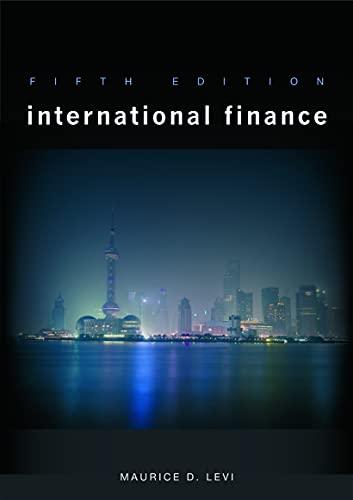Question
1. A Singaporean bank makes a one-year loan to an Australian corporate borrower at 6 percent annual interest. The loan is funded by issuing 5-year
1. A Singaporean bank makes a one-year loan to an Australian corporate borrower at 6 percent annual interest. The loan is funded by issuing 5-year bonds in the US at 4 percent annual coupon rate. Currently, spot exchange rates are 1.02 Singaporean Dollar per AUD and 0.74 US dollar per Singaporean dollar. The bank is exposed to :
a) interest rate , foreign exchange risk and liquidity risk.
b) credit risk only.
c) interest rate risk, foreign exchange risk and credit risk.
d) interest rate risk only.
e) foreign exchange risk only.
2. What does a relatively low ratio of loans to deposits indicate?
a) Depository institution has large amounts of asset-side liquidity.
b) Depository institution relies relatively less heavily on borrowed funds to fund loans, therefore it is exposed to higher liquidity risk.
c) Depository institution relies relatively less heavily on core deposits to fund loans, therefore it is exposed to higher liquidity risk.
d) Depository institution relies relatively less heavily on borrowed funds to fund loans, therefore it is exposed to lower liquidity risk.
e) Depository institution has low levels of asset-side liquidity.
3. When a bank makes a loan commitment at a fixed interest rate, the bank is NOT exposed to which one of the following risks:
a) draw-down risk.
b) credit risk.
c) basis risk.
d) interest rate risk.
e) aggregate funding risk.
4. Which of the following statements about credit decisions is NOT correct?
a) Financial institutions use both interest rates and credit quantity to control credit risk for wholesale (large business) loans.
b) Beyond some critical interest rate, wholesale loans may be rationed through loan quantity restrictions.
c) Household borrowers involve lower costs of information collection for lenders.
d) Retail customers are more likely to be rationed through loan quantity restrictions than through interest rates .
e) Retail loans tend to be smaller than wholesale loans.
5. Assume the interest rate in the market for one-year zero-coupon government bonds is i = 7% and the rate for one-year zero-coupon grade BB bonds is k = 11.5%. What is the implied probability of default on the corporate bond (round to two decimals)?
a) 95.96%
b) 4.04%
c) 94.95%
d) 3.24%
e) 5.05%
6. The duration of a soon to be approved loan of $15 million is 4 years. The increase in credit risk premium for bonds belonging to the same risk category of the loan has been estimated to be 4.5 per cent. What is the capital at risk if the current average level of interest rates for this category of bonds is 10 percent?
a) $1,964,285.71
b) $357,142.86
c) $2,755,357.14
d) $1,789,565
e) $2,454,545.45
7. ABC Bank is charging a 10 percent interest rate on a $7,000,000 loan. The bank has a cost of funds of 6 percent. The borrower has a 4 percent chance of default, and if default occurs, the bank expects to recover 95 percent of the principal and interest. What is the expected return on the loan using the KMV model?
a) 4.00%
b) 5.80%
c) 0.20%
d) 5%
e) 3.80%
8. If a bank portfolio manager wants to shorten the bank's liability maturity, what type of risk is she concerned about?
a) Liquidity risk
b) Default risk
c) Credit risk.
d) The risk of rising interest rates
e) The risk of falling interest rates.
9. Instead of structuring its balance sheet to have a zero leverage duration gap, a bank can hedge interest rate risk by using
a) Loan commitments
b) Coupon paying bonds
c) Rate sensitive liabilities
d) Rate sensitive assets
e) Interest rate swaps
10. A bank that finances short term loans with long term bonds is exposed to
a) decrease in net interest income and decrease in the market value of equity when interest rates increase.
b) decrease in net interest income and decrease in the market value of equity when interest rates decrease.
c) decrease in net interest income and increase in the market value of equity when interest rates decrease.
d) decrease in net interest income and increase in the market value of equity when interest rates increase.
e) increase in net interest income and increase in the market value of equity when interest rates decrease
Step by Step Solution
There are 3 Steps involved in it
Step: 1

Get Instant Access to Expert-Tailored Solutions
See step-by-step solutions with expert insights and AI powered tools for academic success
Step: 2

Step: 3

Ace Your Homework with AI
Get the answers you need in no time with our AI-driven, step-by-step assistance
Get Started


